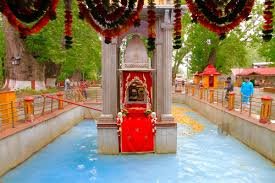Pushkar, a town known for its spiritual significance and cultural richness, is home to many ancient temples. Among them, the Raghunath Temple stands as a prominent and revered site for pilgrims and visitors alike. Dedicated to Lord Vishnu, the Raghunath Temple offers a deep spiritual experience. And combined with a fascinating history, rich architecture, and serene surroundings. This blog takes you through the importance, history, architecture, and significance of the Raghunath Temple in Pushkar. And showcasing why it continues to attract devotees from across the world.
The Origins of Raghunath Temple
The Raghunath Temple is believed to have been established in the 18th century, though its exact date of construction remains uncertain. It is dedicated to Lord Vishnu, one of the most revered deities in Hinduism, who is worshipped in his form as Raghunath, the one who saved the world from evil. The temple holds a special place in the hearts of the people of Pushkar, being considered a central place of devotion.
According to legend, the temple was built to mark Lord Vishnu’s manifestation in the form of Raghunath. Local tales suggest that a devotee of Lord Vishnu, who was a resident of Pushkar. Had a divine vision in which the deity instructed him to build a temple. As a result, the temple came into existence, bringing a surge of spiritual devotion and faith to the region.
Historical Significance
Raghunath Temple holds immense historical and cultural importance. The temple’s establishment was believed to be a result of Lord Vishnu’s divine intervention, and over the years, it has been a focal point for both locals and pilgrims. Its association with Lord Vishnu gives it a special place within the religious landscape of Pushkar. A town known for its sacred connection to various deities.
Raghunath Temple also has historical significance due to its connection with the Rajput rulers of Rajasthan. The temple has seen several renovations and additions, particularly during the reign of various kings who were patrons of the temple. These royal connections further elevated the temple’s prestige, adding to its rich history and cultural heritage.
Architecture of Raghunath Temple
The architecture of the Raghunath Temple is a fine blend of traditional Rajput and Maru-Gurjara architectural styles, offering an aesthetically pleasing and peaceful environment for worshippers. As you approach the temple, you are greeted by its distinct, elegant spires that tower over the city, inviting devotees to come closer and partake in its sacredness.
The sanctum sanctorum houses an idol of Lord Vishnu in his Raghunath form, sitting majestically on a pedestal, while the surrounding walls feature detailed depictions of various scenes from Hindu mythology.
Pilgrimage and Spiritual Significance
The Raghunath Temple holds great spiritual significance, not just for the people of Pushkar but also for Hindu devotees across India. As a prominent temple dedicated to Lord Vishnu, it attracts people seeking blessings for prosperity, health, and spiritual growth. Devotees flock to the temple to offer prayers and seek the divine grace of Lord Vishnu, who is believed to offer protection, strength, and guidance to his followers.
The temple is considered especially auspicious during important religious festivals such as Diwali, Janmashtami, and Ram Navami. During these festivals, the temple is beautifully decorated, and elaborate rituals and prayers are performed. Devotees participate in the ceremonies with great enthusiasm, seeking blessings for a prosperous life.
The temple’s association with Lord Vishnu’s Raghunath form makes it a significant spiritual destination. And for those seeking solace and divine intervention. Many believe that visiting the temple helps one attain mental peace, emotional balance, and a deeper connection with the divine.
Festivals and Celebrations at Raghunath Temple
One of the main reasons for the temple’s popularity is its celebration of various festivals throughout the year. The temple comes alive with vibrant rituals and activities, particularly during religious occasions.
Ram Navami, the celebration of Lord Rama’s birth, is one of the most important festivals at the Raghunath Temple. The temple is decorated with flowers, lights, and offerings as devotees gather to celebrate the occasion with fervor. Special prayers, hymns, and devotional songs are sung throughout the day, creating a festive atmosphere.
Diwali, the festival of lights, is another important occasion when the Raghunath Temple sees a large number of visitors. The temple is illuminated with oil lamps, and the idol of Lord Vishnu is adorned with beautiful decorations. Devotees come to offer prayers, light diyas, and seek blessings for prosperity and happiness.
Janmashtami, the birth of Lord Krishna, is also celebrated with great enthusiasm. Devotees participate in midnight prayers and rituals, singing bhajans and hymns to mark the occasion.
During these festivals, the temple is filled with an aura of devotion and excitement.
How to Reach Raghunath Temple
Reaching Raghunath Temple is relatively easy, as it is located in the heart of Pushkar, a town well-connected to major cities in Rajasthan. For those traveling by train, the nearest railway station is Ajmer Junction, which is approximately 14 kilometers away from Pushkar. From Ajmer, one can take a taxi or bus to reach the temple.
If you are traveling by air, the nearest airport is in Jaipur, which is about 150 kilometers away. From Jaipur, you can hire a taxi or take a bus to reach Pushkar. Once in Pushkar, the temple is easily accessible by foot or through local transport.
Conclusion: A Divine Experience at Raghunath Temple
The Raghunath Temple in Pushkar is a beacon of spirituality, rich history, and architectural grandeur. Whether you are a devotee seeking the blessings of Lord Vishnu or simply a traveler in search of experiencing Rajasthan’s cultural heritage. The temple offers an unforgettable experience.
A visit to the Raghunath Temple is not only a spiritual journey but also an opportunity to immerse yourself in the heart of Pushkar’s sacred landscape. As you walk through its hallowed halls, surrounded by history, culture, and faith, you can’t help but feel a deep sense of peace and devotion that will stay with you long after you leave.
.





